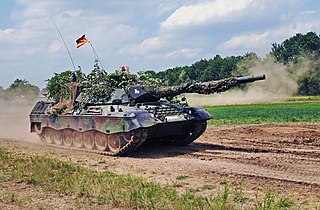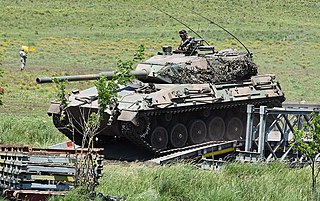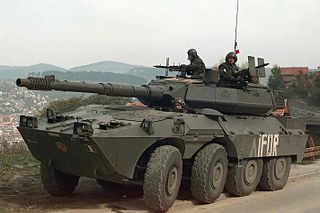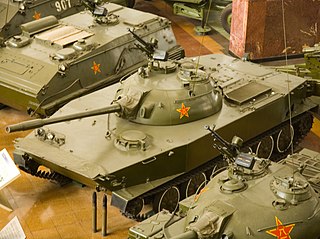
An anti-aircraft vehicle, also known as a self-propelled anti-aircraft gun (SPAAG) or self-propelled air defense system (SPAD), is a mobile vehicle with a dedicated anti-aircraft capability.

The Kampfpanzer Leopard is a main battle tank designed by Porsche and manufactured by Krauss-Maffei in West Germany, first entering service in 1965. Developed in an era when HEAT warheads were thought to make conventional heavy armour of limited value, the Leopard design focused on effective firepower and mobility instead of heavy protection. It featured moderate armour, only effective against low caliber autocannons and heavy machine guns, giving it a high power-to-weight ratio. This, coupled with a modern suspension and drivetrain, gave the Leopard superior mobility and cross-country performance compared to most other main battle tanks of the era, only being rivaled by the French AMX-30 and Swedish Strv 103. The main armament of the Leopard consisted of a German license-built version of the British Royal Ordnance L7 105 mm rifled gun, one of the most effective and widespread tank guns of the era.

The Leopard 2 is a third generation German main battle tank (MBT). Developed by Krauss-Maffei in the 1970s, the tank entered service in 1979 and replaced the earlier Leopard 1 as the main battle tank of the West German army. Various iterations of the Leopard 2 continue to be operated by the armed forces of Germany, as well as 13 other European countries, and several non-European countries, including Canada, Chile, Indonesia, and Singapore. Some operating countries have licensed the Leopard 2 design for local production and domestic development.

The Wiesel Armoured Weapons Carrier (AWC) is a German light air-transportable armoured fighting vehicle, more specifically a lightly armoured weapons carrier, produced by Rheinmetall.

The Tanque Argentino Mediano is a medium tank in service with the Argentine Army. Lacking the experience and resources to design a tank, the Argentine Ministry of Defense contracted German company Thyssen-Henschel. The vehicle was developed by a German and Argentine team of engineers, and was based on the German Marder infantry fighting vehicle chassis.

The Schützenpanzer Marder 1 is a tracked German infantry fighting vehicle designed for use with the West German Panzergrenadiere units, mechanized infantry specialized for IFV combat. It has been operated by the German Army as the main Panzergrenadiere IFV since the 1970s through to the present day. Developed as part of the rebuilding of West Germany's armoured fighting vehicle industry, the Marder has proven to be a successful and solid infantry fighting vehicle design.

The Flugabwehrkanonenpanzer Gepard is an all-weather-capable German self-propelled anti-aircraft gun (SPAAG) based on the hull of the Leopard 1. It was developed in the 1960s, fielded in the 1970s, and has been upgraded several times with the latest electronics. It has been a cornerstone of the air defence of the German Army (Bundeswehr) and a number of other NATO countries.

The ZSU-57-2 Ob'yekt 500 is a Soviet self-propelled anti-aircraft gun (SPAAG), armed with two 57 mm autocannons. 'ZSU' stands for Zenitnaya Samokhodnaya Ustanovka, meaning "anti-aircraft self-propelled mount", '57' stands for the bore of the armament in millimetres and '2' stands for the number of gun barrels. It was the first Soviet mass-produced tracked SPAAG. In the USSR, it had the unofficial nickname Sparka, meaning "twin mount," referring to the twin autocannon with which the vehicle is armed.

The T95 was an American prototype medium tank developed from 1955 to 1959. These tanks used many advanced or unusual features, such as siliceous-cored armor, new transmissions, and OPTAR fire-control systems. The OPTAR incorporated an electro-optical rangefinder and was mounted on the right side of the turret, and was used in conjunction with the APFSDS-firing 90 mm T208 smoothbore gun, which had a rigid mount without a recoil system. In addition, although the tanks were designed with a torsion beam suspension, a hydropneumatic suspension was fitted, and one of the tanks was fitted with a Solar Saturn gas turbine for demonstration purposes.

The Centauro is a family of Italian military vehicles originating from a wheeled tank destroyer for light to medium territorial defense and tactical reconnaissance. It was developed by a consortium of manufacturers, the Società Consortile Iveco Fiat - OTO Melara (CIO). Iveco Fiat was tasked with developing the hull and propulsion systems while Oto Melara was responsible for developing the turrets and weapon systems.

The SK-105 Kürassier is an Austrian light tank armed with a rifled 105 mm gun in an oscillating turret. It is estimated that over 700 have been produced, with initial deliveries in 1971. It shares its CN 105-57 main gun with the French AMX-13, which was widely produced and deployed.
The Henschel Wehrtechnik TH-200, TH-400, and TH-800 are a family of wheeled armoured fighting vehicles by Thyssen-Henschel. Their development was loosely related to the Spähpanzer Luchs.

The WZ-551 is a Chinese wheeled infantry fighting vehicle family. The name WZ-551 actually covers two families of vehicles with the official designations in the People's Liberation Army (PLA) – Type 90 and Type 92. Over 3,000 WZ-551s are in service with the PLA, where they are used by medium mechanized infantry units.

The Norinco Type 63 is a Chinese amphibious light tank. First fielded in 1963, it is in many ways similar to the earlier Soviet PT-76. However, contrary to the popular belief, it does have some essential differences from the PT-76 in the vehicle's waterjet propulsion system, etc. It is also known under its industrial designation, the WZ-211. Type 63 is being replaced by Type 63A.

The Type 80 and the Type 88 are a family of Chinese second-generation main battle tanks (MBTs). They are also known as the ZTZ80 and ZTZ88.
Object 187, was a Soviet experimental main battle tank developed between the late 1980s and middle 1990s. It remains a relatively unpublicized development because of high levels of secrecy surrounding the project.
The VK 45.01 (P), also informally known as Tiger (P) or Porsche Tiger, was a heavy tank prototype designed by Porsche in Germany. With a dual engine gasoline-electric drive that was complex and requiring significant amounts of copper, it lost out to its Henschel competitor on trials, it was not selected for mass production and the Henschel design was produced as the Tiger I. Most of the already produced chassis were rebuilt as Elefant Panzerjager tank destroyers.
The Vickers Main Battle Tank Mk. 4 later known as the Vickers Valiant was a main battle tank developed as a private venture by British company Vickers for export. Its development began in 1976 and ended in January 1984. Although the Valiant did not enter production, its development provided valuable experience in the production of an aluminium-hulled, Chobham-armoured tank in the 40 tonnes weight range. A further development of its turret was later used for the Vickers Mk. 7 MBT.
The Vickers Main Battle Tank Mark 7 was a main battle tank developed on the basis of a joint venture between Vickers Defence Systems in the United Kingdom and Krauss-Maffei of Germany. It combined the Leopard 2 chassis with the Universal Turret previously developed for the Vickers Valiant main battle tank. The Vickers Mk. 7 was a key milestone in the development of the Challenger 2 as many of the features developed and successfully demonstrated in the turret of the Vickers Mk. 7 were later incorporated into the Challenger 2.














